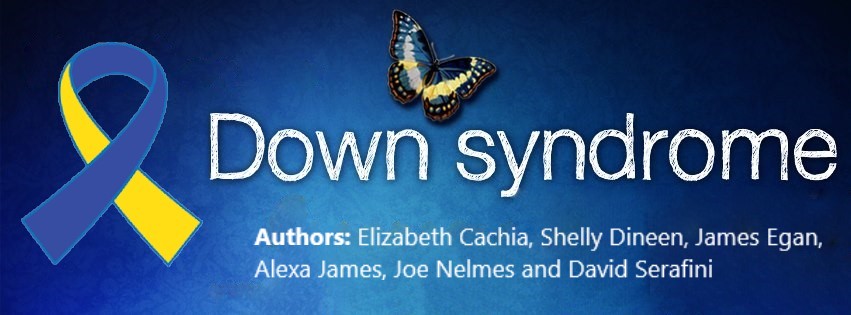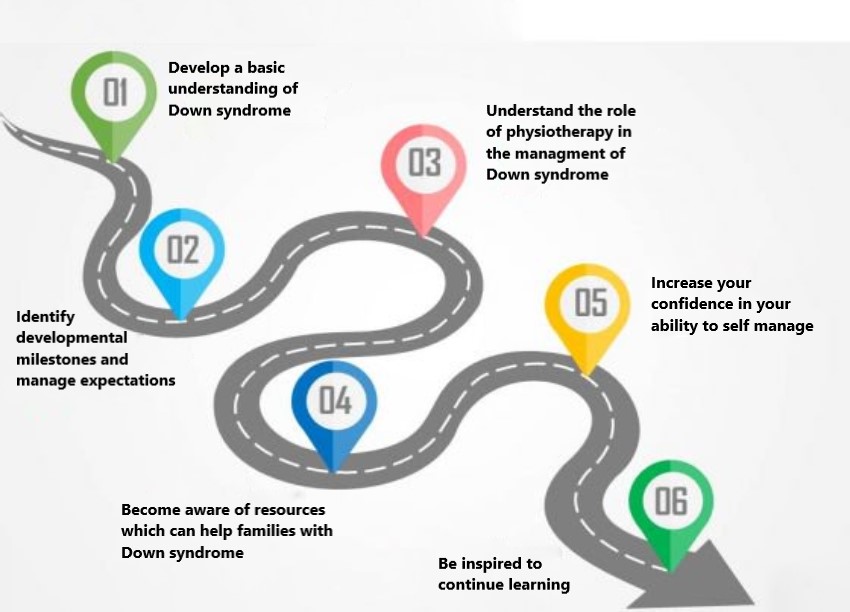Down Syndrome (Trisomy 21)
Introduction[edit | edit source]
Welcome! This resource is intended for families of persons with Down syndrome (DS). It is common for members of families with an individual who has DS to seek out information to better understand the unique challenges ahead and to prepare for the future. There are a large number of resources available regarding Down syndrome, and this may be overwhelming and intimidating.
The purpose of this educational resource is to consolidate and clarify the information found in current literature to make learning easier. This will provide families of persons with DS a comprehensive, easily understood learning resource that they can feel confident in consulting. This resource further intends to educate families about what to expect throughout the lifespan of an individual with DS, ease concerns, and highlight the role of physiotherapy in the care and management of Down syndrome. After reading this resource, it is the hope of the authors that readers will feel encouraged and confident, allowing the family to better manage and cope at home. We hope that families will be better able to understand when and how to seek professional guidance, should they require support.
Why is this Wiki Important?[edit | edit source]
DS is the most commonly occurring chromosomal variance noted world-wide,[1] with 1 in 700 births resulting in a child with DS[2]. In the UK alone, there are over 41,000 people living with down syndrome, and 750 new people born with DS each year [3]. Birth rates are expected to stay the same, but the total population of persons with DS is expected to rise in the coming years. This is mainly due to medical advancements which have increased the life expectancy of people with DS from age 9 in 1929, to 60 years of age today [4]. With this increase in number and age of this population, there will be larger demand on health services and increased challenges for families to overcome. Furthermore, persons with DS report having problems gaining access to health care[5] with the main barrier being a lack of knowledge about available services[6].
This wiki is therefore a necessary educational tool for families to consult whenever they have questions and are unable to reach a health professional. It will also identify what is to be expected over the lifespan of a person with DS and how families can best self-manage at home. It will highlight potential issues and provide resources for family members should they require assistance.
Learning Journey[edit | edit source]
It is the goal of the authors that after reading this page you will:
What is Down Syndrome? [edit | edit source]
As mentioned above, DS is a chromosomal alteration. Chromosomes are structures found in every cell of our body that contain genetic material. Typically, each cell has 23 pairs of chromosomes, with half coming from each parent (NDSS 2018). Down syndrome however, occurs when chromosome 21 has a full or partial extra copy in some, or all, of that individual’s cells. This triple copy is sometimes called trisomy 21 (Newton et al. 2015). The altered number of chromosomes leads to common physical features in the DS population, such as:
- Narrow, slanted eyes
- Flat noses
- Short stature
- Short neck
- Smaller heads, ears and mouths
- Short wide feet and hands with short fingers and toes
- Protruding thick tongue
- Hand creases across entire hand
DS itself is not a medical condition and is simply a common variation in the human form. However, there are many medical conditions that people with DS frequently experience. These include:
- Cardiac defects
- Hypothyroidism
- Obesity
- Learning difficulties
- Hearing and Vision loss
- Dementia and Alzheimer’s disease
- Leukaemia (Mazurek and Wyka 2015)
Though there are many similarities across the DS population, there is great variation in the syndrome. There are three types of DS, each with its own set of challenges and individual variation. The three types of DS are Trisomy 21, Translocation and Mosaicism. Further information on the differences between categories can be found here.
Whichever the type, persons with DS typically have poorer overall health at a young age and exhibit a greater loss of health, mobility, and increased secondary complications as they age when compared to their non-DS counterparts (BILD 2014, Cruzado and Vargas 2013). Physiotherapists are commonly consulted to educate individuals and their families as well as provide input on health promotion and long-term condition management (CSP 2017). As treatment often requires ongoing maintenance, physiotherapists have become increasingly reliant on family members to support and implement home treatment plans in an attempt to encourage self-management (Middleton and Kitchen 2008). Due to the variation in all people and across Down syndrome cases, no one physiotherapy intervention can be prescribed. Interventions are based on the individual’s physical and intellectual needs, as well as his or her personal strengths and limitations (NHDRI 2010). Some of the common issues that physiotherapists will address are:
- Delayed developmental milestones
- Strength
- Mobility
- Balance issues
Developmental Milestones[edit | edit source]
Common Myths Debunked[edit | edit source]
Conclusion[edit | edit source]
References[edit | edit source]
see adding references tutorial.
- ↑ NATIONAL DOWN SYNDROME SOCIETY. 2018. Down syndrome fact sheet [online]. [viewed 14 March 2018]. Available from: www.ndss.org/wp-content/uploads/2017/08/NDSS-Fact-Sheet-Language-Guide-2015.pdf
- ↑ CIPRIANI, G., DANTI, S., CARLESI, C. and FIORINO, M., 2018. Aging with down syndrome: the dual diagnosis: alzheimer's disease and down syndrome. American Journal of Alzheimer's Disease and Other Dementias [online]. January [viewed 14 March 2018]. Available from: www.journals.sagepub.com/doi/pdf/10.1177/1533317518761093
- ↑ CARR, J. and COLLINS, S. 2018. 50 years with down syndrome: a longitudinal study. Journal of Applied Research in Intellectual Disabilities [online]. March [viewed 14 March 2018]. Available from: https://www.ncbi.nlm.nih.gov/pubmed/29498451
- ↑ ZHU, J., HASLE, H., CORREA, A., SCHENDEL, D., FRIEDMAN, J., OLSEN, J. and RASMUSSEN, S. 2013. Survival among people with down syndrome. Genetics in Medicine [online]. vol. 15, pp. 64-69 [viewed 12 March 2018]. Available from: https://www.nature.com/articles/gim201293
- ↑ ALLERTON, L. and EMERSON. E., 2012. British adults with chronic health conditions or impairments face significant barriers to accessing health services. Public Health [online]. vol. 126, pp. 920-927 [viewed 13 March 2018]. Available from: https://www.ncbi.nlm.nih.gov/pubmed/22959282
- ↑ NATIONAL HEALTH SERVICE., 2006. Promoting access to healthcare for people with a learning disability. [viewed 14 March 2018]. Available from: www.jpaget.nhs.uk/media/186386/promoting_access_to_healtcare_for_people_with_learning_disabilities_a_guide_for_frontline_staff.pdf








